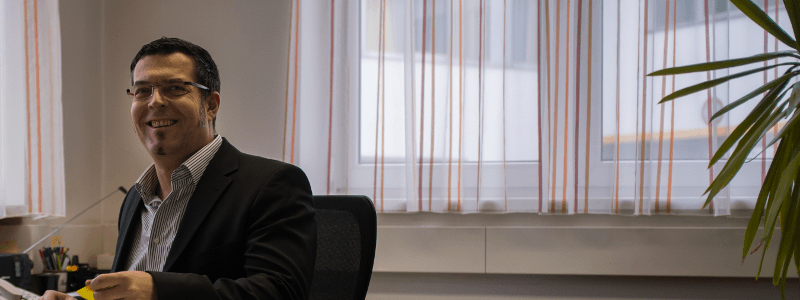Time Tracking at Constantia Teich GmbH with Time Cockpit

With 800 employees, Constantia Teich GmbH is a leading company of Constantia Flexibles. The international enterprise is one of the world's leading suppliers of flexible packaging material. Using the prime raw materials aluminium, paper and plastics, high quality and innovative products are manufactured for use in the Dairy, Confectionery, Human Food / Pet Food industry, as well as for international Pharmaceutical companies. In December 2012 we visited wintry Weinburg to talk with members of Constantia Teich’s management team about time tracking in Shared Service Center (SSC) organizations in general and time cockpit in particular.
Rainer Stropek, co-founder and CEO of time cockpit, had the conversation with:
- Mr. DI Robert Nährer, IT Manager (in the image above)
- Ms. Mag. Gabriele Schuh, SSC MS Dynamics AX
- Ms. Sabine Endmaier, Director Finance and Accounting
- Mr. Martin Frank, IT Manager Data Warehouse & Reporting
Why Time Tracking?
Time tracking plays an important role in Constantia Teich’s shared service centers, because services are provided by central departments and have to be charged to the different subsidiaries accordingly. The shared service center organization started in the IT department. Today other departments like accounting follow the same form of organization.
Transparency and Fairness
 Pot sealing system by Constantia Teich
Pot sealing system by Constantia TeichConstantia Teich decided to go for a fine-grained cost allocation model. Ms. Schuh describes why a coarse-grained cost splitting approach would not be sufficient for the company: “Our main goal is to allocate costs according to the causative principle. We work project-oriented. It would be unfair to charge equal costs to all internal customers. We assign costs to the originating department.”
Mr. Naehrer adds: „We have consistent key performance indicators used in the entire Constantia Flexibles Group. Strategic decisions are based on these KPIs. They would be diluted if we did not handle centrally provided services specifically. Therefore we need appropriate cost allocation. We decided to accurately track our work to offer our internal customers a detailed statement of costs. They can reconstruct what the service centers did for them.”
Implementation of the Shared Service Center Organization
In contrast to other enterprises, Constantia Teich decided not to spin off shared service centers as separate service companies. The service centers reside in two production subsidiaries. Mr. Naehrer emphasises: “The engagement of a direct employee is different from an employee in an outsourced service firm.” Ms. Endmair: “The employees of our production subsidiaries have valuable, domain-specific know-how from which we want to benefit.”
Cost Allocation Using the Cost-Plus Method
In many companies the definition of internal cost rates for services is challenging. Constantia Teich decided to use the Cost-Plus method. Mr. Nährer describes: “We allocate 100% of our costs plus a markup as we would also invoice to every other costumer. We have usage-dependent prices and all-inclusive fees for certain IT standard services. We calculate the prices yearly and charge based on the planned usage. At the end of the year we do post calculations and charge or credit the differences.”
Why Time Cockpit?
The team emphasizes time cockpit’s good usability when we asked them for the most important reasons for using the tool. They value time cockpit for its UI in combination with the unique signal tracker functionality and its Outlook-Calendar integration.
Mr. Naehrer describes his personal experience with time cockpit’s signal trackers like this: “I think that the big difference of time cockpit, compared to its competitors, is the Signal Tracker. Many colleagues create their time sheet bookings rather promptly – but not in real time. Time cockpit’s signal trackers help to remember what you have done throughout the day. I often take a look at the collected WLAN signals for example.” Mr. Frank adds: “Some colleagues ask me about time cockpit because they just want to find out how they have spent their time. If time cockpit’s signal tracker show you quite some time for Outlook, you know that you have been busy handling your emails and you couldn’t spend much time on projects on that day.”
Extensibility and SAP Integration
Beside usability and signal trackers, Constantia Teich recognizes time cockpit for its extensibility. Mr. Frank says, that the ability to tailor the tool to their specific needs without losing the advantages of using a component-of-the-shelve software was important to him. Constantia Teich extended time cockpit with an automated interface to SAP for things like users and cost center master data. Mr. Naehrer: “If you really want an integrated solution, you need specific, internal know-how to set it up. You have to automate interfaces between the system components. This is what we successfully did.”
Software as a Service
Being a company with subsidiaries all over the world, Constantia Teich has existing data centers. However, the IT department of Constantia Teich does not have a negative view of Software as a Service (SaaS). “SaaS fits well to our concept of internal cost allocation. Internally we charge our shared services monthly, not daily like for instance time cockpit. External SaaS solutions like time cockpit follow the same principles that we have established inside Constantia Flexibles. ”
Project Information
The time cockpit project at Constantia Teich has been implemented in cooperation with cubido business solutions gmbh. Cubido is a time cockpit sales and implementation partner.